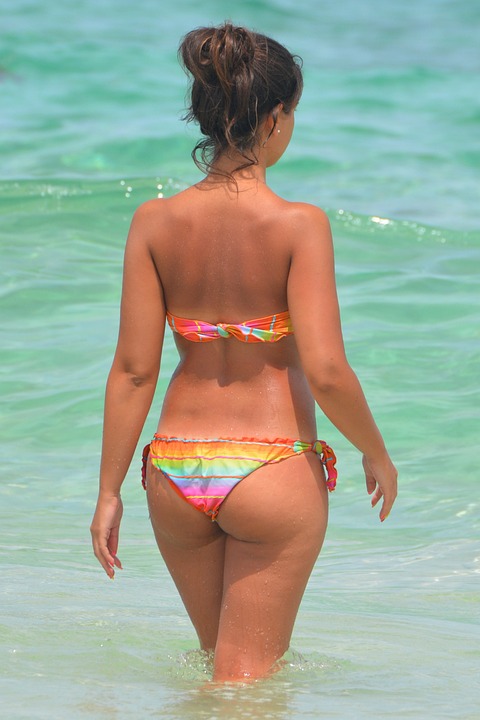Understanding Bikini Line Rash After Shaving: Causes, Prevention, and Treatment
Imagine this scenario: you’ve just finished shaving your Bikini Line, hoping for a smooth and flawless result. But instead, you’re left with an annoying and uncomfortable rash. If you’ve experienced this, you’re not alone. Many women encounter Bikini Line rashes after shaving, and it can be quite perplexing. In this article, we will delve into the reasons behind this issue, explore preventive measures, and discuss effective treatments. So, let’s dive in!
What Causes Bikini Line Rash After Shaving?
Shaving the delicate skin around the Bikini Line can lead to various issues, including irritation, redness, itching, and even painful ingrown hairs. There are several factors that contribute to these bothersome rashes:
1.
Blade Irritation:
The most common cause of Bikini Line rash is blade irritation. When you shave, the sharp blades can scrape against the sensitive skin, causing redness and inflammation. This irritation can be exacerbated by using old or dull blades, as they are more likely to tug at the hairs rather than smoothly cutting them.
2.
Ingrown Hairs:
Ingrown hairs occur when the hair follicles become clogged, trapping the hair beneath the surface of the skin. Shaving can increase the likelihood of ingrown hairs, especially if you shave against the natural direction of hair growth or if your skin is not properly exfoliated before shaving.
3.
Skin Sensitivity:
Some individuals have naturally sensitive skin, which can be easily irritated by shaving. This sensitivity can be further aggravated by harsh shaving products, such as soaps or gels that contain harsh chemicals or fragrances.
4.
Friction and Clothing:
After shaving, the newly exposed skin can be more susceptible to friction from tight clothing or underwear, leading to irritation and chafing.
5.
Poor Aftercare:
Neglecting proper post-shave care can also contribute to Bikini Line rashes. Failing to moisturize or using products with irritating ingredients can exacerbate the problem.
Prevention Tips to Avoid Bikini Line Rash
Fortunately, there are several measures you can take to prevent Bikini Line rashes after shaving. By following these simple tips, you can maintain smooth and irritation-free skin:
1.
Prepare the Skin:
Before you begin shaving, it’s crucial to prepare your skin properly. Gently exfoliating the Bikini area with a mild scrub or a soft brush can help remove dead skin cells and reduce the likelihood of ingrown hairs.
2.
Use a Sharp Razor:
Always use a sharp, clean razor to ensure a smooth shave. Dull blades can cause more friction and irritation, increasing the chances of developing a rash. Replace your razor blades regularly to maintain optimal sharpness.
3.
Shave in the Right Direction:
Shaving in the direction of hair growth can minimize the risk of ingrown hairs and irritation. Avoid the temptation to shave against the grain, as this can lead to more discomfort.
4.
Choose Gentle Products:
Opt for shaving creams, gels, or soaps specifically designed for sensitive skin. Look for products that are fragrance-free and free from harsh chemicals that can irritate the skin.
5.
Moisturize and Soothe:
After shaving, apply a gentle moisturizer or aloe vera gel to soothe the skin and lock in moisture. This step can help reduce redness and inflammation, promoting faster healing.
Effective Treatments for Bikini Line Rash
If you’ve already developed a Bikini Line rash despite taking preventive measures, don’t fret. There are effective treatments available to alleviate the discomfort and promote healing:
1.
Cool Compress:
Applying a cool compress or ice pack to the affected area can provide immediate relief from itching and inflammation. The cold temperature helps reduce redness and soothes the irritated skin.
2.
Topical Creams:
Over-the-counter hydrocortisone creams or ointments can be applied to the rash to reduce inflammation and itching. However, it’s important to follow the instructions and consult a healthcare professional if the rash persists or worsens.
3.
Warm Baths:
Soaking in a warm bath can help open up the hair follicles and reduce the chances of developing ingrown hairs. Adding a cup of Epsom salt to the bathwater can further aid in soothing the irritated skin.
4.
Avoid Tight Clothing:
To prevent further irritation, opt for loose-fitting clothing made from breathable fabrics. This allows the skin to breathe and reduces friction, aiding in the healing process.
5.
Seek Professional Advice:
If the rash persists or becomes severe, it’s advisable to seek advice from a dermatologist or healthcare professional. They can provide personalized guidance and prescribe suitable medications if necessary.
In conclusion, dealing with a Bikini Line rash after shaving can be frustrating, but with the right preventive measures and treatments, you can overcome this common issue. By understanding the causes, taking proper precautions, and seeking appropriate treatment when needed, you can maintain smooth and healthy skin in your Bikini area. Remember, everyone’s skin is unique, so it may take some trial and error to find the best routine for you. Stay patient, and don’t let a little rash dampen your confidence!
Most Asked Queries About Bikini Line Rash After Shaving
What causes Bikini Line rash after shaving?
Bikini Line rash after shaving can be caused by various factors. One of the main causes is irritation from shaving against the direction of hair growth, which can lead to redness, bumps, and itchiness. Another common cause is using a dull or dirty razor, as this can cause friction and introduce bacteria to the skin, leading to irritation and infection. Additionally, sensitive skin or allergies to certain shaving products can also contribute to Bikini Line rash after shaving.
The three most important pieces of information to remember about the causes of Bikini Line rash after shaving are:
1. Shaving against the direction of hair growth can cause irritation and redness.
2. Using a dull or dirty razor can lead to friction and bacterial infection.
3. Sensitive skin or allergies to shaving products can also contribute to Bikini Line rash.
How can I prevent Bikini Line rash after shaving?
Preventing Bikini Line rash after shaving requires a few simple steps. First, it is important to prepare the skin before shaving by exfoliating gently to remove dead skin cells and prevent ingrown hairs. Using a clean and sharp razor is essential to minimize friction and reduce the risk of infection. Shaving in the direction of hair growth can also help prevent irritation. After shaving, it is important to rinse the area with cool water and apply a soothing, alcohol-free moisturizer to calm the skin.
The three most important pieces of information to remember about preventing Bikini Line rash after shaving are:
1. Exfoliating before shaving helps remove dead skin cells and prevent ingrown hairs.
2. Using a clean and sharp razor reduces friction and the risk of infection.
3. Applying a soothing, alcohol-free moisturizer after shaving helps calm the skin.
How can I treat a Bikini Line rash after shaving?
If you develop a Bikini Line rash after shaving, there are several steps you can take to treat it. First, it is important to keep the area clean and dry to prevent further irritation and infection. Applying a cold compress or using aloe vera gel can help reduce redness and soothe the skin. Over-the-counter hydrocortisone cream can also be effective in reducing inflammation. Avoiding further shaving until the rash has healed is recommended to allow the skin to recover.
The three most important pieces of information to remember about treating a Bikini Line rash after shaving are:
1. Keeping the area clean and dry is important to prevent further irritation and infection.
2. Applying a cold compress or aloe vera gel can help reduce redness and soothe the skin.
3. Over-the-counter hydrocortisone cream can be effective in reducing inflammation.
When should I see a doctor for a Bikini Line rash after shaving?
While most cases of Bikini Line rash after shaving can be treated at home, there are certain situations where it is advisable to see a doctor. If the rash is severe, spreads rapidly, or is accompanied by intense pain or fever, it may indicate an infection and medical attention should be sought. Additionally, if the rash does not improve within a few days of home treatment, it is recommended to consult a healthcare professional for further evaluation and guidance.
The three most important pieces of information to remember about when to see a doctor for a Bikini Line rash after shaving are:
1. Seek medical attention if the rash is severe, spreads rapidly, or is accompanied by intense pain or fever.
2. If the rash does not improve within a few days of home treatment, consult a healthcare professional.
3. A doctor can provide further evaluation and guidance for persistent or severe cases.
Are there any preventive measures for Bikini Line rash after shaving?
Yes, there are several preventive measures you can take to minimize the risk of developing a Bikini Line rash after shaving. Firstly, make sure to always use a clean and sharp razor to reduce friction and the risk of infection. Shaving in the direction of hair growth can help prevent irritation and ingrown hairs. It is also important to avoid using harsh or irritating shaving products, and instead opt for gentle, fragrance-free options. Lastly, regularly exfoliating the skin and moisturizing afterwards can help keep the skin healthy and reduce the likelihood of developing a rash.
The three most important pieces of information to remember about preventive measures for Bikini Line rash after shaving are:
1. Use a clean and sharp razor to reduce friction and the risk of infection.
2. Shave in the direction of hair growth to prevent irritation and ingrown hairs.
3. Avoid harsh or irritating shaving products and opt for gentle, fragrance-free options.
1. Bikini Line rash is always caused by shaving
Contrary to popular belief, not all Bikini Line rashes are solely caused by shaving. While shaving can contribute to irritation and redness in the Bikini area, there are several other factors that can lead to a rash. For instance, tight clothing, friction from exercise or activities, allergic reactions to certain fabrics or products, and even hormonal imbalances can all play a role in developing a Bikini Line rash.
2. All rashes after shaving the Bikini Line are the same
Another common misconception is that all rashes that occur after shaving the Bikini Line are identical. In reality, there are various types of rashes that can manifest in this area, each with its own causes and symptoms. Some individuals may experience razor burn, which is characterized by redness, itchiness, and small bumps, while others may develop ingrown hairs or folliculitis, which is an infection of the hair follicles. It is crucial to identify the specific type of rash in order to determine the appropriate treatment.
3. Only improper shaving techniques cause Bikini Line rash
While it is true that improper shaving techniques can contribute to Bikini Line rash, it is not the sole cause. Factors such as using a dull razor, not adequately moisturizing the skin before and after shaving, shaving against the direction of hair growth, or applying too much pressure can all increase the risk of developing a rash. However, even with proper shaving techniques, some individuals may still experience irritation due to their skin’s sensitivity or other underlying factors.
4. Shaving creams and gels prevent Bikini Line rash
Many individuals believe that using shaving creams or gels can prevent Bikini Line rash. While these products can provide lubrication and help reduce friction during shaving, they do not guarantee complete protection against rashes. It is essential to choose a shaving cream or gel that is suitable for your skin type and free from harsh chemicals or fragrances that may cause irritation. Additionally, proper shaving techniques and post-shave care are equally important in minimizing the risk of developing a rash.
5. Bikini Line rash will always resolve on its own
Some people mistakenly assume that a Bikini Line rash will naturally go away on its own without any intervention. While this may be true for mild cases of irritation or razor burn, more severe rashes or those caused by infections may require medical attention. Ignoring persistent or worsening symptoms can lead to further complications, such as the spread of infection or scarring. It is important to monitor the rash closely and seek medical advice if it does not improve within a reasonable timeframe or if it becomes increasingly painful or inflamed.


